Surface Charge: An Advantage for the Piezoelectric Properties of GaN Nanowires
Abstract
1. Introduction
2. Materials and Methods
3. Results and Discussions
- -
- The piezo-conversion firstly depends on the deformation degree of the material.
- -
- The piezo-conversion is directly related to the conductivity/resistivity of the NWs.
4. Conclusions
Supplementary Materials
Author Contributions
Funding
Data Availability Statement
Acknowledgments
Conflicts of Interest
References
- Yang, P.; Yan, R.; Fardy, M. Semiconductor Nanowire: What’s Next? Nano Lett. 2010, 10, 1529–1536. [Google Scholar] [CrossRef] [PubMed]
- Qi, Y.; McAlpine, M.C. Nanotechnology-Enabled Flexible and Biocompatible Energy Harvesting. Energy Environ. Sci. 2010, 3, 1275–1285. [Google Scholar] [CrossRef]
- Chang, C.; Tran, V.H.; Wang, J.; Fuh, Y.-K.; Lin, L. Direct-Write Piezoelectric Polymeric Nanogenerator with High Energy Conversion Efficiency. Nano Lett. 2010, 10, 726–731. [Google Scholar] [CrossRef] [PubMed]
- Wang, Z.L.; Song, J. Piezoelectric Nanogenerators Based on Zinc Oxide Nanowire Arrays. Science 2006, 312, 242–246. [Google Scholar] [CrossRef] [PubMed]
- Chen, C.-Y.; Liu, T.-H.; Zhou, Y.; Zhang, Y.; Chueh, Y.-L.; Chu, Y.-H.; He, J.-H.; Wang, Z.L. Electricity Generation Based on Vertically Aligned PbZr0.2Ti0.8O3 Nanowire Arrays. Nano Energy 2012, 1, 424–428. [Google Scholar] [CrossRef]
- Lin, Y.-F.; Song, J.; Ding, Y.; Lu, S.-Y.; Wang, Z.L. Piezoelectric Nanogenerator Using CdS Nanowires. Appl. Phys. Lett. 2008, 92, 022105. [Google Scholar] [CrossRef]
- Zhou, Y.S.; Wang, K.; Han, W.; Rai, S.C.; Zhang, Y.; Ding, Y.; Pan, C.; Zhang, F.; Zhou, W.; Wang, Z.L. Vertically Aligned CdSe Nanowire Arrays for Energy Harvesting and Piezotronic Devices. ACS Nano 2012, 6, 6478–6482. [Google Scholar] [CrossRef] [PubMed]
- Wang, Z.; Hu, J.; Suryavanshi, A.P.; Yum, K.; Yu, M.-F. Voltage Generation from Individual BaTiO3 Nanowires under Periodic Tensile Mechanical Load. Nano Lett. 2007, 7, 2966–2969. [Google Scholar] [CrossRef] [PubMed]
- Kang, P.G.; Lee, T.K.; Ahn, C.W.; Kim, I.W.; Lee, H.H.; Choi, S.B.; Sung, K.D.; Jung, J.H. Vertically Aligned Epitaxial KNbO3 Nanorod Array for Piezoelectric Energy Harvester and Second Harmonic Generator. Nano Energy 2015, 17, 261–268. [Google Scholar] [CrossRef]
- Alekseev, P.A.; Sharov, V.A.; Geydt, P.; Dunaevskiy, M.S.; Lysak, V.V.; Cirlin, G.E.; Reznik, R.R.; Khrebtov, A.I.; Soshnikov, I.P.; Lähderanta, E. Piezoelectric Current Generation in Wurtzite GaAs Nanowires. Phys. Status Solidi Rapid Res. Lett. 2018, 12, 1700358. [Google Scholar] [CrossRef]
- Gogneau, N.; Chrétien, P.; Galopin, E.; Guilet, S.; Travers, L.; Harmand, J.-C.; Houzé, F. GaN Nanowires for Piezoelectric Generators. Phys. Status Solidi Rapid Res. Lett. 2014, 8, 414–419. [Google Scholar] [CrossRef]
- Jegenyes, N.; Morassi, M.; Chrétien, P.; Travers, L.; Lu, L.; Julien, F.; Tchernycheva, M.; Houzé, F.; Gogneau, N. High Piezoelectric Conversion Properties of Axial InGaN/GaN Nanowires. Nanomaterials 2018, 8, 367. [Google Scholar] [CrossRef] [PubMed]
- Gogneau, N.; Jamond, N.; Chrétien, P.; Houzé, F.; Lefeuvre, E.; Tchernycheva, M. From Single III-Nitride Nanowires to Piezoelectric Generators: New Route for Powering Nomad Electronics. Semicond. Sci. Technol. 2016, 31, 103002. [Google Scholar] [CrossRef]
- Gao, P.X.; Song, J.; Liu, J.; Wang, Z.L. Nanowire Piezoelectric Nanogenerators on Plastic Substrates as Flexible Power Sources for Nanodevices. Adv. Mater. 2007, 19, 67–72. [Google Scholar] [CrossRef]
- Lu, M.-P.; Song, J.; Lu, M.-Y.; Chen, M.-T.; Gao, Y.; Chen, L.-J.; Wang, Z.L. Piezoelectric Nanogenerator Using P-Type ZnO Nanowire Arrays. Nano Lett. 2009, 9, 1223–1227. [Google Scholar] [CrossRef]
- Pawar, O.Y.; Patil, S.L.; Redekar, R.S.; Patil, S.B.; Lim, S.; Tarwal, N.L. Strategic Development of Piezoelectric Nanogenerator and Biomedical Applications. Appl. Sci. 2023, 13, 2891. [Google Scholar] [CrossRef]
- Lu, L.; Jamond, N.; Chrétien, P.; Houzé, F.; Travers, L.; Harmand, J.C.; Glas, F.; Julien, F.H.; Lefeuvre, E.; Gogneau, N.; et al. Nitride Nanowires: From Rigid to Flexible Piezo-Generators. J. Phys. Conf. Ser. 2016, 773, 012010. [Google Scholar] [CrossRef]
- Waseem, A.; Johar, M.A.; Hassan, M.A.; Bagal, I.V.; Abdullah, A.; Ha, J.-S.; Lee, J.K.; Ryu, S.-W. Flexible Self-Powered Piezoelectric Pressure Sensor Based on GaN/p-GaN Coaxial Nanowires. J. Alloys Compd. 2021, 872, 159661. [Google Scholar] [CrossRef]
- Johar, M.A.; Waseem, A.; Hassan, M.A.; Bagal, I.V.; Abdullah, A.; Ha, J.; Ryu, S. Highly Durable Piezoelectric Nanogenerator by Heteroepitaxy of GaN Nanowires on Cu Foil for Enhanced Output Using Ambient Actuation Sources. Adv. Energy Mater. 2020, 10, 2002608. [Google Scholar] [CrossRef]
- Ye, S.; Cheng, C.; Chen, X.; Chen, X.; Shao, J.; Zhang, J.; Hu, H.; Tian, H.; Li, X.; Ma, L.; et al. High-Performance Piezoelectric Nanogenerator Based on Microstructured P(VDF-TrFE)/BNNTs Composite for Energy Harvesting and Radiation Protection in Space. Nano Energy 2019, 60, 701–714. [Google Scholar] [CrossRef]
- Cha, S.; Kim, S.M.; Kim, H.; Ku, J.; Sohn, J.I.; Park, Y.J.; Song, B.G.; Jung, M.H.; Lee, E.K.; Choi, B.L.; et al. Porous PVDF As Effective Sonic Wave Driven Nanogenerators. Nano Lett. 2011, 11, 5142–5147. [Google Scholar] [CrossRef] [PubMed]
- Zhu, G.; Wang, A.C.; Liu, Y.; Zhou, Y.; Wang, Z.L. Functional Electrical Stimulation by Nanogenerator with 58 V Output Voltage. Nano Lett. 2012, 12, 3086–3090. [Google Scholar] [CrossRef] [PubMed]
- Dahiya, A.S.; Morini, F.; Boubenia, S.; Justeau, C.; Nadaud, K.; Rajeev, K.P.; Alquier, D.; Poulin-Vittrant, G. Zinc Oxide Nanowire-Parylene Nanocomposite Based Stretchable Piezoelectric Nanogenerators for Self-Powered Wearable Electronics. J. Phys. Conf. Ser. 2018, 1052, 012028. [Google Scholar] [CrossRef]
- Jamond, N.; Chrétien, P.; Houzé, F.; Lu, L.; Largeau, L.; Maugain, O.; Travers, L.; Harmand, J.C.; Glas, F.; Lefeuvre, E.; et al. Piezo-Generator Integrating a Vertical Array of GaN Nanowires. Nanotechnology 2016, 27, 325403. [Google Scholar] [CrossRef] [PubMed]
- Minary-Jolandan, M.; Bernal, R.A.; Kuljanishvili, I.; Parpoil, V.; Espinosa, H.D. Individual GaN Nanowires Exhibit Strong Piezoelectricity in 3D. Nano Lett. 2012, 12, 970–976. [Google Scholar] [CrossRef] [PubMed]
- Agrawal, R.; Espinosa, H.D. Giant Piezoelectric Size Effects in Zinc Oxide and Gallium Nitride Nanowires. A First Principles Investigation. Nano Lett. 2011, 11, 786–790. [Google Scholar] [CrossRef] [PubMed]
- Zhao, M.-H.; Wang, Z.-L.; Mao, S.X. Piezoelectric Characterization of Individual Zinc Oxide Nanobelt Probed by Piezoresponse Force Microscope. Nano Lett. 2004, 4, 587–590. [Google Scholar] [CrossRef]
- Jamond, N.; Chrétien, P.; Gatilova, L.; Galopin, E.; Travers, L.; Harmand, J.-C.; Glas, F.; Houzé, F.; Gogneau, N. Energy Harvesting Efficiency in GaN Nanowire-Based Nanogenerators: The Critical Influence of the Schottky Nanocontact. Nanoscale 2017, 9, 4610–4619. [Google Scholar] [CrossRef] [PubMed]
- Van de Walle, C.G.; Segev, D. Microscopic Origins of Surface States on Nitride Surfaces. J. Appl. Phys. 2007, 101, 081704. [Google Scholar] [CrossRef]
- Donatini, F.; de Luna Bugallo, A.; Tchoulfian, P.; Chicot, G.; Sartel, C.; Sallet, V.; Pernot, J. Comparison of Three E-Beam Techniques for Electric Field Imaging and Carrier Diffusion Length Measurement on the Same Nanowires. Nano Lett. 2016, 16, 2938–2944. [Google Scholar] [CrossRef]
- Zhernokletov, D.M.; Negara, M.A.; Long, R.D.; Aloni, S.; Nordlund, D.; McIntyre, P.C. Interface Trap Density Reduction for Al2O3/GaN (0001) Interfaces by Oxidizing Surface Preparation Prior to Atomic Layer Deposition. ACS Appl. Mater. Interfaces 2015, 7, 12774–12780. [Google Scholar] [CrossRef] [PubMed]
- Siva Pratap Reddy, M.; Im, K.-S.; Lee, J.-H.; Caulmione, R.; Cristoloveanu, S. Trap and 1/f-Noise Effects at the Surface and Core of GaN Nanowire Gate-All-around FET Structure. Nano Res. 2019, 12, 809–814. [Google Scholar] [CrossRef]
- Lüth, H. Solid Surfaces, Interfaces and Thin Films; Springer International Publishing: Cham, Switzerland, 2015; ISBN 978-3-319-10755-4. [Google Scholar]
- Polenta, L.; Rossi, M.; Cavallini, A.; Calarco, R.; Marso, M.; Meijers, R.; Richter, T.; Stoica, T.; Lüth, H. Investigation on Localized States in GaN Nanowires. ACS Nano 2008, 2, 287–292. [Google Scholar] [CrossRef] [PubMed]
- Zhang, Z.; Yates, J.T., Jr. Band Bending in Semiconductors: Chemical and Physical Consequences at Surfaces and Interfaces. Chem. Rev. 2012, 112, 5520–5551. [Google Scholar] [CrossRef] [PubMed]
- King, P.D.C.; Veal, T.D.; Payne, D.J.; Bourlange, A.; Egdell, R.G.; McConville, C.F. Surface electron accumulation and the charge neutrality level in In2O3. Phys. Rev. Lett. 2008, 101, 116808. [Google Scholar] [CrossRef] [PubMed]
- Bodecker, H.V.; Hornig, G. Link Invariants of Electromagnetic Fields. Phys. Rev. Lett. 2004, 92, 30406. [Google Scholar] [CrossRef] [PubMed]
- Noguchi, M.; Hirakawa, K.; Ikoma, T. Intrinsic Electron Accumulation Layers on Reconstructed Clean InAs(100) Surfaces. Phys. Rev. Lett. 1991, 66, 2243–2246. [Google Scholar] [CrossRef] [PubMed]
- Calarco, R.; Stoica, T.; Brandt, O.; Geelhaar, L. Surface-Induced Effects in GaN Nanowires. J. Mater. Res. 2011, 26, 2157–2168. [Google Scholar] [CrossRef]
- Lopez Garcia, A.J.L.; Mouis, M.; Consonni, V.; Ardila, G. Dimensional Roadmap for Maximizing the Piezoelectrical Response of ZnO Nanowire-Based Transducers: Impact of Growth Method. Nanomaterials 2021, 11, 941. [Google Scholar] [CrossRef]
- Park, C.H.; Chadi, D.J. Stability of Deep Donor and Acceptor Centers in GaN, AlN, and BN. Phys. Rev. B 1997, 55, 12995–13001. [Google Scholar] [CrossRef]
- Qiu, C.H.; Pankove, J.I. Deep Levels and Persistent Photoconductivity in GaN Thin Films. Appl. Phys. Lett. 1997, 70, 1983–1985. [Google Scholar] [CrossRef]
- Lin, T.Y.; Yang, H.C.; Chen, Y.F. Optical Quenching of the Photoconductivity in N-Type GaN. J. Appl. Phys. 2000, 87, 3404–3408. [Google Scholar] [CrossRef]
- Kresse, G.; Dulub, O.; Diebold, U. Competing Stabilization Mechanism for the Polar ZnO(0001)-Zn Surface. Phys. Rev. B 2003, 68, 245409. [Google Scholar] [CrossRef]
- Son, J.; Chobpattana, V.; McSkimming, B.M.; Stemmer, S. In-Situ Nitrogen Plasma Passivation of Al2O3/GaN Interface States. J. Vac. Sci. Technol. A Vac. Surf. Film. 2015, 33, 020602. [Google Scholar] [CrossRef]
- Soudi, A.; Hsu, C.-H.; Gu, Y. Diameter-Dependent Surface Photovoltage and Surface State Density in Single Semiconductor Nanowires. Nano Lett. 2012, 12, 5111–5116. [Google Scholar] [CrossRef] [PubMed]
- Xue, X.; Nie, Y.; He, B.; Xing, L.; Zhang, Y.; Wang, Z.L. Surface Free-Carrier Screening Effect on the Output of a ZnO Nanowire Nanogenerator and Its Potential as a Self-Powered Active Gas Sensor. Nanotechnology 2013, 24, 225501. [Google Scholar] [CrossRef] [PubMed]
- Wang, C.-H.; Liao, W.-S.; Lin, Z.-H.; Ku, N.-J.; Li, Y.-C.; Chen, Y.-C.; Wang, Z.-L.; Liu, C.-P. Optimization of the Output Efficiency of GaN Nanowire Piezoelectric Nanogenerators by Tuning the Free Carrier Concentration. Adv. Energy Mater. 2014, 4, 1400392. [Google Scholar] [CrossRef]
- Tao, R.; Mouis, M.; Ardila, G. Unveiling the Influence of Surface Fermi Level Pinning on the Piezoelectric Response of Semiconducting Nanowires. Adv. Electron. Mater. 2018, 4, 1700299. [Google Scholar] [CrossRef]
- Liu, J.; Fei, P.; Song, J.; Wang, X.; Lao, C.; Tummala, R.; Wang, Z.L. Carrier Density and Schottky Barrier on the Performance of DC Nanogenerator. Nano Lett. 2008, 8, 328–332. [Google Scholar] [CrossRef]
- Hinchet, R.; Lee, S.; Ardila, G.; Montès, L.; Mouis, M.; Wang, Z.L. Performance Optimization of Vertical Nanowire-Based Piezoelectric Nanogenerators. Adv. Funct. Mater. 2014, 24, 971–977. [Google Scholar] [CrossRef]
- Sohn, J.I.; Cha, S.N.; Song, B.G.; Lee, S.; Kim, S.M.; Ku, J.; Kim, H.J.; Park, Y.J.; Choi, B.L.; Wang, Z.L.; et al. Engineering of Efficiency Limiting Free Carriers and an Interfacial Energy Barrier for an Enhancing Piezoelectric Generation. Energy Environ. Sci. 2013, 6, 97–104. [Google Scholar] [CrossRef]
- Gao, J.; Zhang, X.; Sun, Y.; Zhao, Q.; Yu, D. Compensation Mechanism in N-Doped ZnO Nanowires. Nanotechnology 2010, 21, 245703. [Google Scholar] [CrossRef] [PubMed]
- Lee, K.Y.; Bae, J.; Kim, S.; Lee, J.-H.; Yoon, G.C.; Gupta, M.K.; Kim, S.; Kim, H.; Park, J.; Kim, S.-W. Depletion Width Engineering via Surface Modification for High Performance Semiconducting Piezoelectric Nanogenerators. Nano Energy 2014, 8, 165–173. [Google Scholar] [CrossRef]
- Hu, Y.; Lin, L.; Zhang, Y.; Wang, Z.L. Replacing a Battery by a Nanogenerator with 20 V Output. Adv. Mater. 2012, 24, 110–114. [Google Scholar] [CrossRef] [PubMed]
- Xu, S.; Xu, C.; Liu, Y.; Hu, Y.; Yang, R.; Yang, Q.; Ryou, J.-H.; Kim, H.J.; Lochner, Z.; Choi, S.; et al. Ordered Nanowire Array Blue/Near-UV Light Emitting Diodes. Adv. Mater. 2010, 22, 4749–4753. [Google Scholar] [CrossRef] [PubMed]
- Garcia, A.J.L.; Jalabert, T.; Pusty, M.; Defoor, V.; Mescot, X.; Montanino, M.; Sico, G.; Loffredo, F.; Villani, F.; Nenna, G.; et al. Size and Semiconducting Effects on the Piezoelectric Performances of ZnO Nanowires Grown onto Gravure-Printed Seed Layers on Flexible Substrates. Nanoenergy Adv. 2022, 2, 197–209. [Google Scholar] [CrossRef]
- Gogneau, N.; Chrétien, P.; Sodhi, T.; Couraud, L.; Leroy, L.; Travers, L.; Harmand, J.-C.; Julien, F.H.; Tchernycheva, M.; Houzé, F. Electromechanical Conversion Efficiency of GaN NWs: Critical Influence of the NW Stiffness, the Schottky Nano-Contact and the Surface Charge Effects. Nanoscale 2022, 14, 4965–4976. [Google Scholar] [CrossRef]
- Lu, S.; Liao, Q.; Qi, J.; Liu, S.; Liu, Y.; Liang, Q.; Zhang, G.; Zhang, Y. The Enhanced Performance of Piezoelectric Nanogenerator via Suppressing Screening Effect with Au Particles/ZnO Nanoarrays Schottky Junction. Nano Res. 2016, 9, 372–379. [Google Scholar] [CrossRef]
- Largeau, L.; Galopin, E.; Gogneau, N.; Travers, L.; Glas, F.; Harmand, J.-C. N-Polar GaN Nanowires Seeded by Al Droplets on Si(111). Cryst. Growth Des. 2012, 12, 2724–2729. [Google Scholar] [CrossRef]
- Brubaker, M.D.; Levin, I.; Davydov, A.V.; Rourke, D.M.; Sanford, N.A.; Bright, V.M.; Bertness, K.A. Effect of AlN Buffer Layer Properties on the Morphology and Polarity of GaN Nanowires Grown by Molecular Beam Epitaxy. J. Appl. Phys. 2011, 110, 053506. [Google Scholar] [CrossRef]
- Bertness, K.A.; Roshko, A.; Mansfield, L.M.; Harvey, T.E.; Sanford, N.A. Nucleation Conditions for Catalyst-Free GaN Nanowires. J. Cryst. Growth 2007, 300, 94–99. [Google Scholar] [CrossRef]
- Largeau, L.; Dheeraj, D.L.; Tchernycheva, M.; Cirlin, G.E.; Harmand, J.C. Facet and In-Plane Crystallographic Orientations of GaN Nanowires Grown on Si(111). Nanotechnology 2008, 19, 155704. [Google Scholar] [CrossRef]
- Songmuang, R.; Landré, O.; Daudin, B. From Nucleation to Growth of Catalyst-Free GaN Nanowires on Thin AlN Buffer Layer. Appl. Phys. Lett. 2007, 91, 251902. [Google Scholar] [CrossRef]
- Jacopin, G.; De Luna Bugallo, A.; Rigutti, L.; Lavenus, P.; Julien, F.H.; Lin, Y.-T.; Tu, L.-W.; Tchernycheva, M. Interplay of the Photovoltaic and Photoconductive Operation Modes in Visible-Blind Photodetectors Based on Axial p-i-n Junction GaN Nanowires. Appl. Phys. Lett. 2014, 104, 023116. [Google Scholar] [CrossRef]
- Massalski, T.B. Binary Alloy Phase Diagrams; ASM International: Almere, The Netherlands, 1986; Volume 2, pp. 164–165. [Google Scholar]
- Saleem, U.; Birowosuto, M.D.; Gogneau, N.; Coquet, P.; Tchernycheva, M.; Wang, H. Yellow and Green Luminescence in Single-Crystal Ge-Catalyzed GaN Nanowires Grown by Low Pressure Chemical Vapor Deposition. Opt. Mater. Express 2017, 7, 1995–2004. [Google Scholar] [CrossRef]
- Le Formal, F.; Tétreault, N.; Cornuz, M.; Moehl, T.; Grätzel, M.; Sivula, K. Passivating Surface States on Water Splitting Hematite Photoanodes with Alumina Overlayers. Chem. Sci. 2011, 2, 737–743. [Google Scholar] [CrossRef]
- Kim, H.; Bae, H.; Bang, S.W.; Kim, S.; Lee, S.H.; Ryu, S.-W.; Ha, J.-S. Enhanced Photoelectrochemical Stability of GaN Photoelectrodes by Al2O3 Surface Passivation Layer. Opt. Express 2019, 27, A206–A215. [Google Scholar] [CrossRef] [PubMed]
- Ek, A.; Reichel, C.; Richter, A.; Benick, J. Influence of Layer Thickness on Passivation Properties in SiOx/Al2O3 Stacks. J. Appl. Phys. 2020, 127, 235303. [Google Scholar] [CrossRef]
- Simon, D.K.; Jordan, P.M.; Mikolajick, T.; Dirnstorfer, I. On the Control of the Fixed Charge Densities in Al2O3-Based Silicon Surface Passivation Schemes. ACS Appl. Mater. Interfaces 2015, 7, 28215–28222. [Google Scholar] [CrossRef]
- Ghods, A.; Zhou, C.; Ferguson, I.T. Enhancement in Electrical and Optical Properties of Field-Effect Passivated GaN Blue Light Emitting Diodes. Semicond. Sci. Technol. 2021, 36, 115018. [Google Scholar] [CrossRef]
- Seo, M.A.; Yoo, J.; Dayeh, S.A.; Picraux, S.T.; Taylor, A.J.; Prasankumar, R.P. Mapping Carrier Diffusion in Single Silicon Core–Shell Nanowires with Ultrafast Optical Microscopy. Nano Lett. 2012, 12, 6334–6338. [Google Scholar] [CrossRef] [PubMed]
- Schneegans, O.; Chretien, P.; Houze, F. Apparatus for Measuring the Local Electrical Resistance of a Surface. French patent, FR 1001940, 2010International PCT, WO2011/138738, 2011. U.S. Patent 9594101 B2, 2017. [Google Scholar]
- Levinshtein, M.E.; Rumyantsev, S.L.; Shur, M.S. (Eds.) Properties of Advanced Semiconductor Materials: GaN, AlN, InN, BN, SiC, SiGe; Wiley: New York, NY, USA, 2001; p. 1. [Google Scholar]
- Gogneau, N.; Chrétien, P.; Galopin, E.; Guilet, S.; Travers, L.; Harmand, J.-C.; Houzé, F. Impact of the GaN Nanowire Polarity on Energy Harvesting. Appl. Phys. Lett. 2014, 104, 213105. [Google Scholar] [CrossRef]
- Liu, M.; Sun, J.; Chen, Q. Influences of Heating Temperature on Mechanical Properties of Polydimethylsiloxane. Sens. Actuators A Phys. 2009, 151, 42–45. [Google Scholar] [CrossRef]
- Pérez-García, B.; Zúñiga-Pérez, J.; Muñoz-Sanjosé, V.; Colchero, J.; Palacios-Lidón, E. Formation and Rupture of Schottky Nanocontacts on ZnO Nanocolumns. Nano Lett. 2007, 7, 1505–1511. [Google Scholar] [CrossRef] [PubMed]
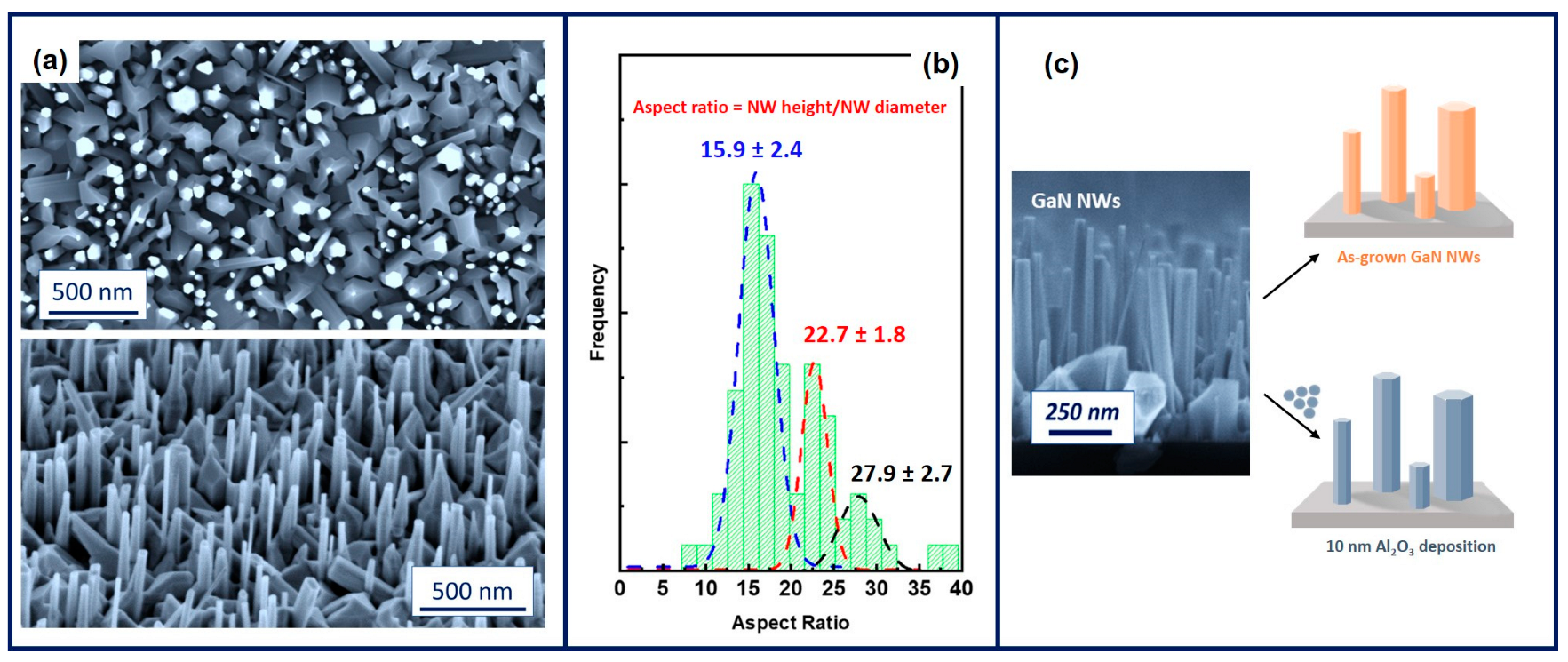
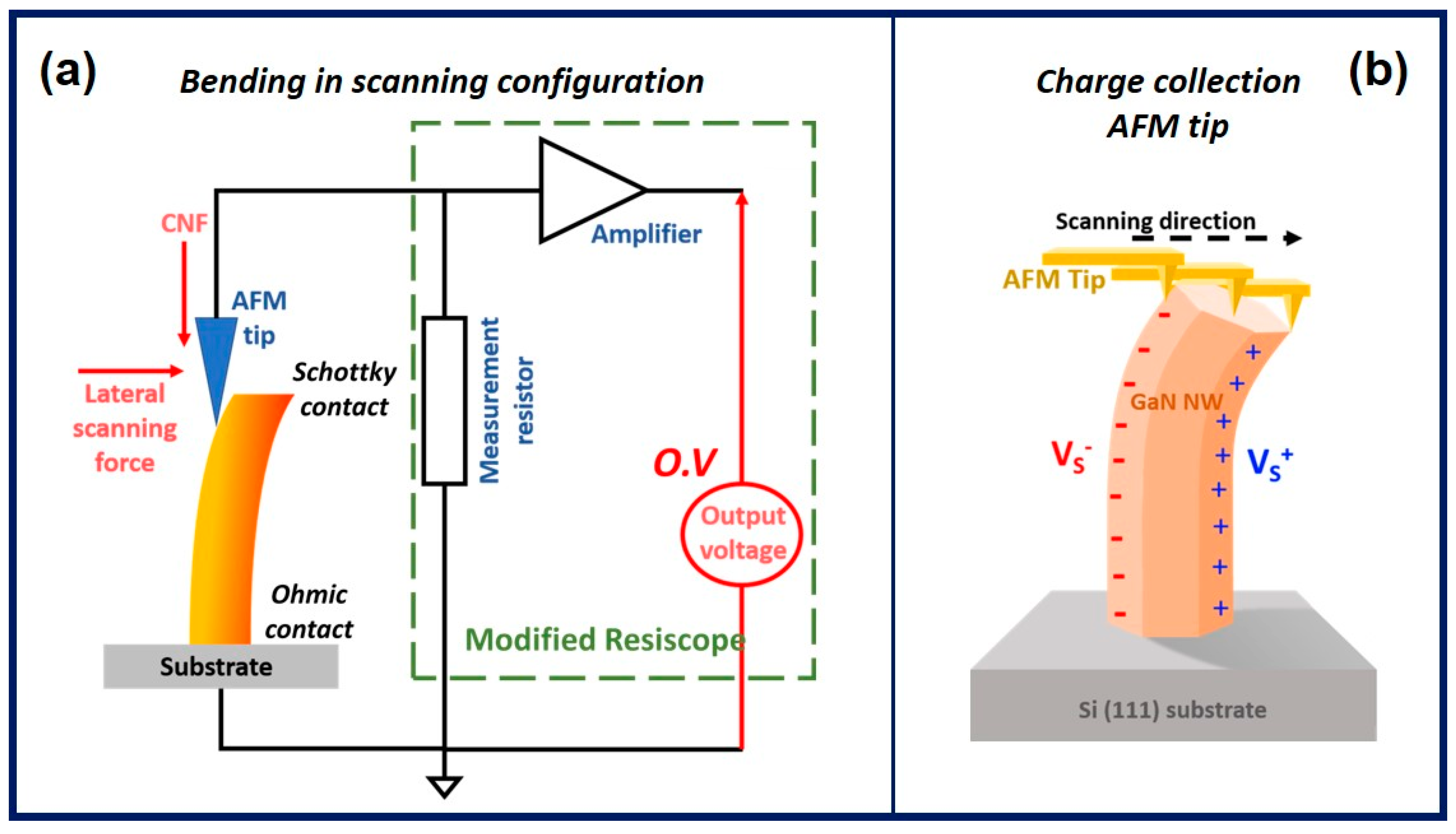

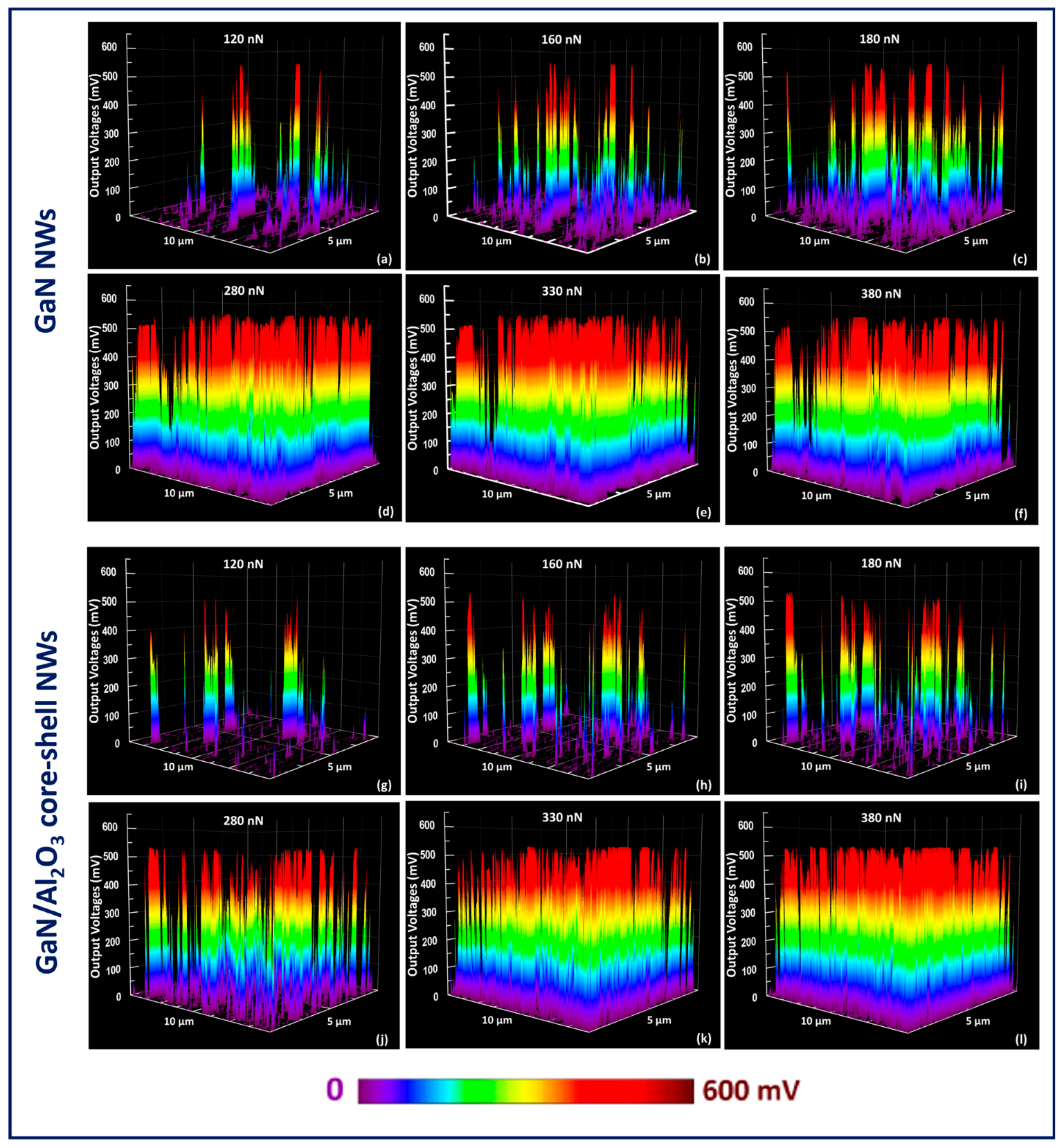

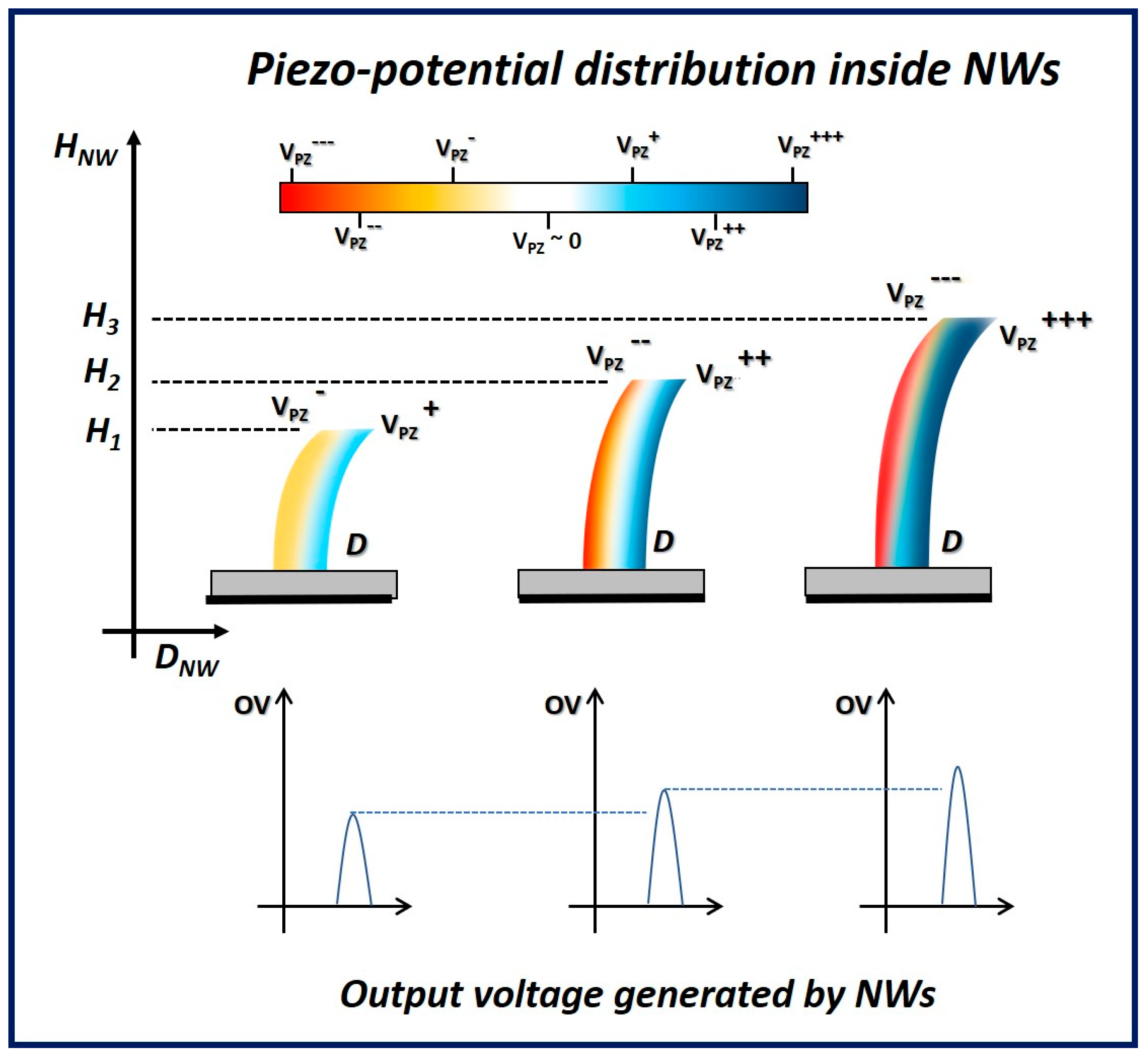
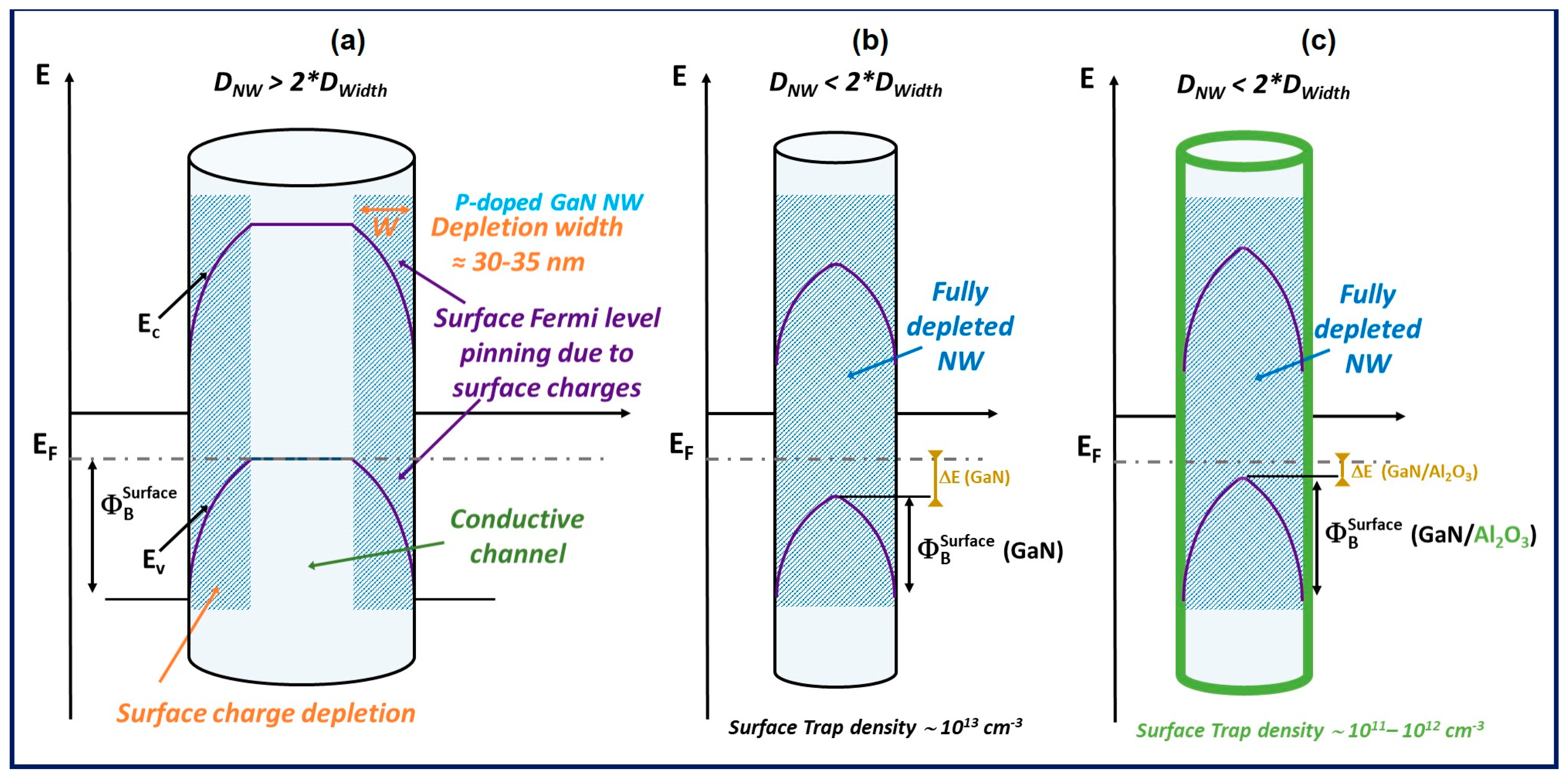
Disclaimer/Publisher’s Note: The statements, opinions and data contained in all publications are solely those of the individual author(s) and contributor(s) and not of MDPI and/or the editor(s). MDPI and/or the editor(s) disclaim responsibility for any injury to people or property resulting from any ideas, methods, instructions or products referred to in the content. |
© 2024 by the authors. Licensee MDPI, Basel, Switzerland. This article is an open access article distributed under the terms and conditions of the Creative Commons Attribution (CC BY) license (https://creativecommons.org/licenses/by/4.0/).
Share and Cite
Sodhi, T.K.; Chrétien, P.; Bui, Q.C.; Chevillard, A.; Travers, L.; Morassi, M.; Tchernycheva, M.; Houzé, F.; Gogneau, N. Surface Charge: An Advantage for the Piezoelectric Properties of GaN Nanowires. Nanoenergy Adv. 2024, 4, 133-146. https://doi.org/10.3390/nanoenergyadv4020008
Sodhi TK, Chrétien P, Bui QC, Chevillard A, Travers L, Morassi M, Tchernycheva M, Houzé F, Gogneau N. Surface Charge: An Advantage for the Piezoelectric Properties of GaN Nanowires. Nanoenergy Advances. 2024; 4(2):133-146. https://doi.org/10.3390/nanoenergyadv4020008
Chicago/Turabian StyleSodhi, Tanbir Kaur, Pascal Chrétien, Quang Chieu Bui, Amaury Chevillard, Laurent Travers, Martina Morassi, Maria Tchernycheva, Frédéric Houzé, and Noelle Gogneau. 2024. "Surface Charge: An Advantage for the Piezoelectric Properties of GaN Nanowires" Nanoenergy Advances 4, no. 2: 133-146. https://doi.org/10.3390/nanoenergyadv4020008
APA StyleSodhi, T. K., Chrétien, P., Bui, Q. C., Chevillard, A., Travers, L., Morassi, M., Tchernycheva, M., Houzé, F., & Gogneau, N. (2024). Surface Charge: An Advantage for the Piezoelectric Properties of GaN Nanowires. Nanoenergy Advances, 4(2), 133-146. https://doi.org/10.3390/nanoenergyadv4020008






